Alan Dunn’s 1,981st New Yorker Drawing
In my earliest days at The New Yorker it seemed to be a gospel truth that Alan Dunn was the most prolific New Yorker artist. I’ve long been fascinated by how such facts are established as fact. I suppose it could be as simple as someone offhandedly saying to a colleague in an elevator one day, “Hey, did you know that Alan Dunn was the most published cartoonist ever at The New Yorker?” and that tidbit, overheard by a fellow elevator passenger, is passed along to a nephew, who passes it along to his mother, and so on and so on.
When it comes to New Yorker history, the search for a source is sometimes fruitless (but never pointless). A look through The New Yorker database (supplied with The Complete New Yorker, and now pretty much useless unless you have a still operational computer from a decade ago) tells us that William Steig’s total far outpaced Dunn’s, with well over 2000 cartoons published and 124 covers. Alan Dunn had 1,981 cartoons published and 9 covers. For Mr. Dunn, those numbers are nothing to sneeze at. He sits comfortably at the top of the list of most published New Yorker artists, along with James Stevenson, Lee Lorenz, and of course, Steig. I can’t say for sure who is #1, #2, #3, and #4 at this point in time because the database ends in February of 2005. At that time Steig was #1, Stevenson #2, Dunn #3, and Lorenz #4. Mr. Lorenz went on to publish many more drawings after 2005. I should point out that James Stevenson’s total New Yorker contributions (he wrote for the magazine as well as contributed covers and cartoons) places him at #1, but we’re only concerning ourselves with art here on the Spill.
But back to Alan Dunn. Fans of New Yorker cartoonist history will immediately associate Mr. Dunn with Mary Petty (Ms. Petty and Mr. Dunn were married). Ms. Petty was one of the earliest New Yorker cartoon gods; no one else drew like her then, or has since (although I see some Petty in Barbara Smaller‘s drawings). Strangely, Ms. Petty was one of the least prolific of all New Yorker cartoon gods. In her long career at The New Yorker (1927- 1966), “only” 219 of her cartoons were published, and 38 covers. I’ve always found it somehow ironic that her husband, despite his out of this world number of published work, is the least known of the most published New Yorker artists. There was just one collection of Mary Petty’s work published. Alan Dunn had half a dozen. Go figure!
All of this Dunn/Petty business came about this evening because I (finally) wondered what Dunn’s last published New Yorker drawing was, and when it appeared (I find firsts and lasts interesting). At the top of this post is Mr. Dunn’s 1,981st New Yorker drawing, published in the issue of September 16, 1974. While we know this was the last of his published, we do not know if this was the last drawing he sold to the magazine, or the last cartoon he ever drew; The New Yorker has a wonderful habit of buying work, storing it, and running it when the spirit moves the “A” issue editor.
The Table Of Contents from Dunn’s final issue appears below. Please note that the September 16, 1974 cover artist is Edward Koren, our longest active cartoon contributor, now in his 60th year of contributing to the magazine. And please further note that among Mr. Koren’s and Mr. Dunn’s colleagues in the issue is George Booth, still going strong in his 53rd year with a New Yorker cover this week in January of 2022.
The Spill entry for each of the artists mentioned above:
Alan Dunn (self portrait above from Meet the Artist) Born in Belmar, New Jersey, August 11, 1900, died in New York City, 1975. NYer work: 1926 – 1974 Key collections: Rejections (Knopf, 1931), Who’s Paying For This Cab? (Simon & Schuster, 1945), A Portfolio of Social Cartoons ( Simon & Schuster, 1968). One of the most published New Yorker cartoonists (1,906 cartoons) , Mr. Dunn was married to Mary Petty — together they lived and worked at 12 East 88th Street, where, according to the NYTs, Alan worked “seated in a small chair at a card table, drawing in charcoal and grease pencil.”
William Steig (photo above) Born in Brooklyn, NY, Nov. 14, 1907, died in Boston, Mass., Oct. 3, 2003. In a New Yorker career that lasted well over half a century and a publishing history that contains more than a cart load of books, both children’s and otherwise, it’s impossible to sum up Steig’s influence here on Ink Spill. He was among the giants of the New Yorker cartoon world, along with James Thurber, Saul Steinberg, Charles Addams, Helen Hokinson and Peter Arno. Lee Lorenz’s World of William Steig (Artisan, 1998) is an excellent way to begin exploring Steig’s life and work. NYer work: 1930 -2003.

James Stevenson Born, NYC, 1929. Died, February 17, 2017, Cos Cob, Connecticut. New Yorker work: March 10, 1956 -. Stevenson interned as an office boy at The New Yorker in the mid 1940s when he began supplying ideas for other New Yorker artists. Nine years later he was hired a full-time ideaman, given an office at the magazine and instructed not to tell anyone what he did. He eventually began publishing his own cartoons and covers as well as a ground-breaking Talk of the Town pieces (ground breaking in that the pieces were illustrated). His contributions to the magazine number over 2000. Key collections: Sorry Lady — This Beach is Private! ( MacMillan, 1963), Let’s Boogie ( Dodd, Mead, 1978). Stevenson was a children’s book author, with roughly one hundred titles to his credit. He was a frequent contributor to the Op-Ed page of The New York Times, under the heading Lost and Found New York. Stevenson’s The Life, Loves and Laughs of Frank Modell, published in 2013, is essential reading. Sally Williams’ 2019 documentary film, Stevenson Lost & Found is essential viewing.

Lee Lorenz ( Pictured above. Photograph taken 1995 by Liza Donnelly) *Born 1932, Hackensack, NJ. Lorenz was the art editor of The New Yorker from 1973 to 1993 and its cartoon editor until 1997. During his tenure, a new wave of New Yorker cartoonists began appearing in the magazine — cartoonists who no longer depended on idea men. Cartoon collections: Here It Comes (Bobbs-Merrrill Co., Inc. 1968) ; Now Look What You’ve Done! (Pantheon, 1977) ; The Golden Age of Trash ( Chronicle Books, 1987); The Essential series, all published by Workman: : Booth (pub: 1998), Barsotti ( pub: 1998), Ziegler (pub: 2001), The Art of The New Yorker 1925 -1995, (Knopf, 1995), The World of William Steig (Artisan, 1998). New Yorker work: 1958 –.
Mary Petty Born, Hampton, New Jersey, April 29, 1899. Died, Paramus, New Jersey, March, 1976. New Yorker work: October 22,1927 – March 19,1966. Collection: This Petty Place ( Knopf, 1945) with a Preface by James Thurber.
Barbara Smaller Born, Chicago, Ill. New Yorker work: 1996 –.


Edward Koren ( photo above, Fall 2016, courtesy of Gil Roth) Born, 1935. New Yorker work: May 26, 1962 — . Key collections: Do You Want To Talk About It? ( Pantheon, 1976), Well, There’s Your Problem (Pantheon, 1980), Caution: Small Ensembles (Pantheon, 1983), What About Me? (Pantheon Books, 1989). Website: edwardkoren.com
George Booth (photo above taken in NYC 2016, courtesy of Liza Donnelly) Born June 28, 1926, Cainesville, MO. New Yorker work: June 14, 1969 – . Key collections: Think Good Thoughts About A Pussycat (Dodd, Mead, 1975), Rehearsal’s Off! (Dodd, Mead, 1976), Omnibooth: The Best of George Booth ( Congdon & Weed, 1984), The Essential George Booth, Compiled and Edited by Lee Lorenz ( Workman, 1998).

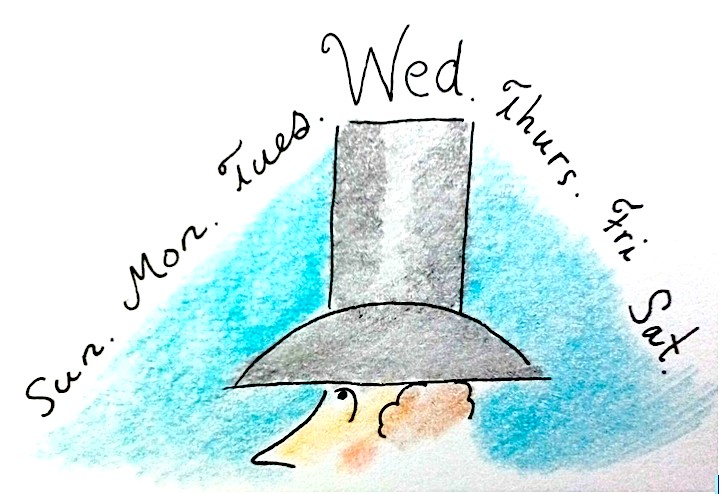
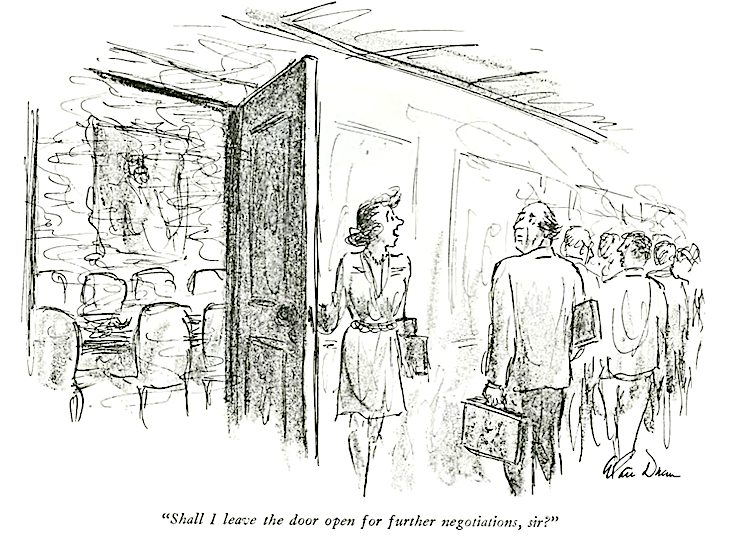
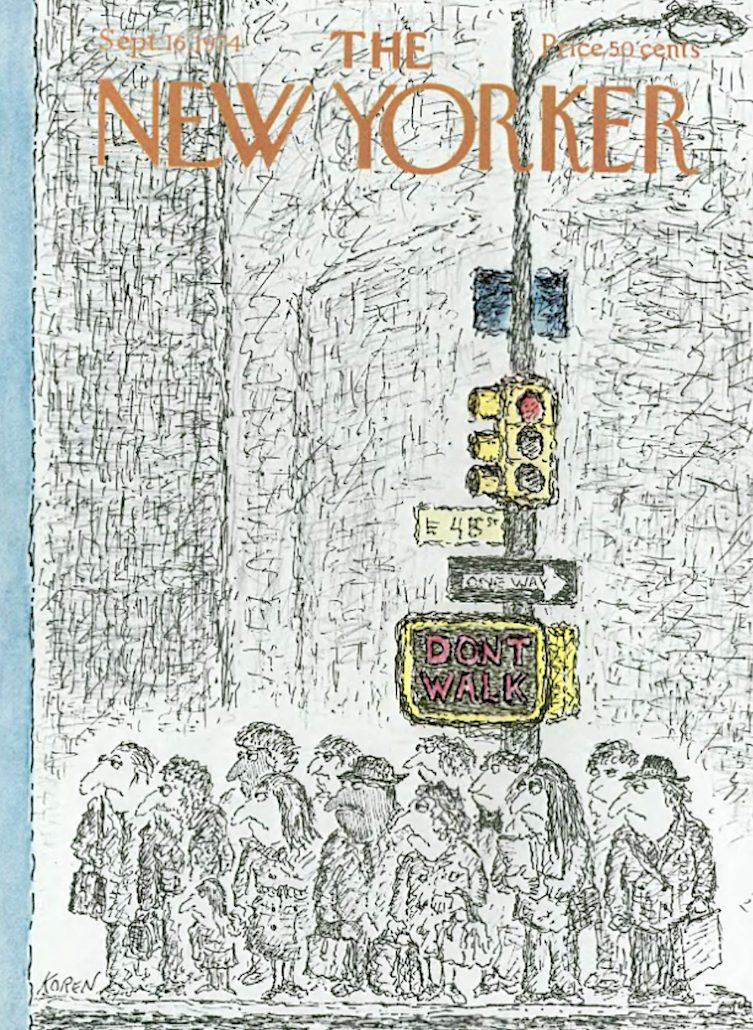




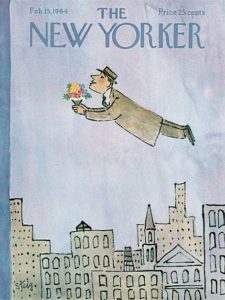

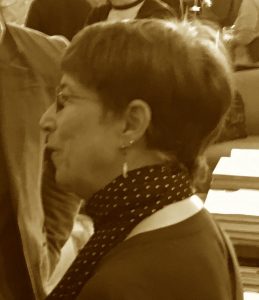



Where can one see some of Mary Petty’s work?
Both the Conde Nast Store and The New Yorker’s Cartoon Bank have a number of her New Yorker covers and drawings. If you want to see original drawings, Syracuse University has a great Mary Petty collection (they have Alan Dunn’s work too).